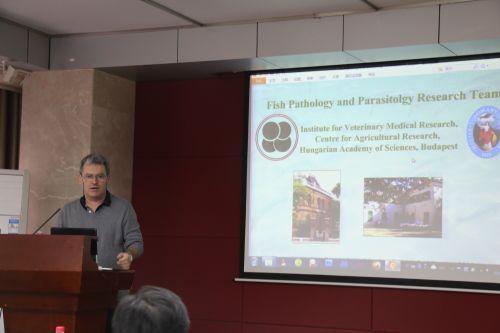
Professor Csaba Székely, director of Fish Disease Research Office, institute of veterinary medicine, agricultural research institute, the Hungarian academy of sciences, attended HZAU aquaculture symposium at the invitation of Professor Gu Zemao and gave a special report named by “Research on fish Parasites”on the morning of Oct. 28th in the 109 Lecture Hall, College of Fisheries. Associate researcher Zhang Jinyong from Institute of Hydrobiology, Professor Gu Zemao and Associate Professor Yang Ruibin from College of Fisheries of HZAU participated in this symposium, which was hosted by Doctor Liu Yang from fish parasite research team.
At the start of the seminar, Professor Csaba Székely introduced the fish parasite research team and present research tasks, achievements and later research plan. Then professor gave a detailed description about fish parasitic nematodes and fish glue spores insects in the following aspects: morphological characteristics, parasitic characteristics, life history and hazards. The Csaba Székely team has isolated large quantities of parasite samples and bred new varieties by conducting thorough investigations on species diversity of fish parasitic nematodes and fish glue spores insects from Hungary and east Asian countries. In the meantime, through the systematic research of Myxosporea life history, the Csaba Székely team identified different stages of Actinosporean of various species. Professor Csaba Székely showed in detail the species diversity and hazards of fish parasites and everyone has a further understanding of parasites’ harms on fishes. In the end, Zhao Dandan, a member of fish parasite research team from the College of Fisheries, informed professor Csaba Székely about her headways in life history of Myxosporea and exchanged views on her problems during her studies.
It is learned that the former chief of the office, Kálmán Molnár had paid a visit to parasite research team from College of Fisheries in 2011. At present, this team has established close cooperation relations with Fish Disease Research Office, institute of veterinary medicine, the Hungarian academy of sciences.
(By Fu ChangRan)
http://news.hzau.edu.cn/2015/1102/43756.shtml
